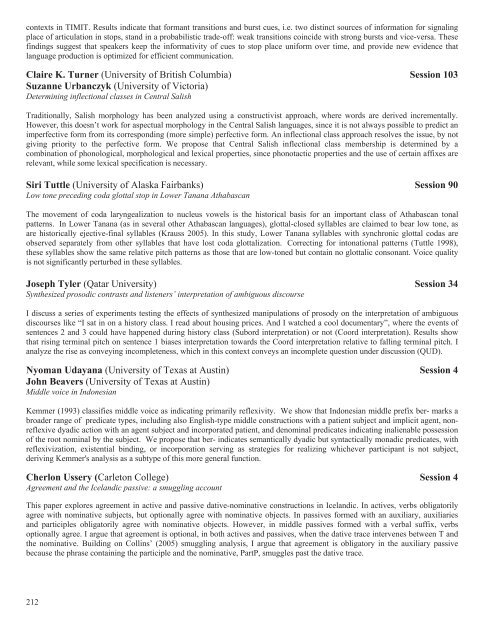here - Linguistic Society of America
here - Linguistic Society of America
here - Linguistic Society of America
You also want an ePaper? Increase the reach of your titles
YUMPU automatically turns print PDFs into web optimized ePapers that Google loves.
contexts in TIMIT. Results indicate that formant transitions and burst cues, i.e. two distinct sources <strong>of</strong> information for signalingplace <strong>of</strong> articulation in stops, stand in a probabilistic trade-<strong>of</strong>f: weak transitions coincide with strong bursts and vice-versa. Thesefindings suggest that speakers keep the informativity <strong>of</strong> cues to stop place uniform over time, and provide new evidence thatlanguage production is optimized for efficient communication.Claire K. Turner (University <strong>of</strong> British Columbia) Session 103Suzanne Urbanczyk (University <strong>of</strong> Victoria)Determining inflectional classes in Central SalishTraditionally, Salish morphology has been analyzed using a constructivist approach, w<strong>here</strong> words are derived incrementally.However, this doesn’t work for aspectual morphology in the Central Salish languages, since it is not always possible to predict animperfective form from its corresponding (more simple) perfective form. An inflectional class approach resolves the issue, by notgiving priority to the perfective form. We propose that Central Salish inflectional class membership is determined by acombination <strong>of</strong> phonological, morphological and lexical properties, since phonotactic properties and the use <strong>of</strong> certain affixes arerelevant, while some lexical specification is necessary.Siri Tuttle (University <strong>of</strong> Alaska Fairbanks) Session 90Low tone preceding coda glottal stop in Lower Tanana AthabascanThe movement <strong>of</strong> coda laryngealization to nucleus vowels is the historical basis for an important class <strong>of</strong> Athabascan tonalpatterns. In Lower Tanana (as in several other Athabascan languages), glottal-closed syllables are claimed to bear low tone, asare historically ejective-final syllables (Krauss 2005). In this study, Lower Tanana syllables with synchronic glottal codas areobserved separately from other syllables that have lost coda glottalization. Correcting for intonational patterns (Tuttle 1998),these syllables show the same relative pitch patterns as those that are low-toned but contain no glottalic consonant. Voice qualityis not significantly perturbed in these syllables.Joseph Tyler (Qatar University) Session 34Synthesized prosodic contrasts and listeners’ interpretation <strong>of</strong> ambiguous discourseI discuss a series <strong>of</strong> experiments testing the effects <strong>of</strong> synthesized manipulations <strong>of</strong> prosody on the interpretation <strong>of</strong> ambiguousdiscourses like “I sat in on a history class. I read about housing prices. And I watched a cool documentary”, w<strong>here</strong> the events <strong>of</strong>sentences 2 and 3 could have happened during history class (Subord interpretation) or not (Coord interpretation). Results showthat rising terminal pitch on sentence 1 biases interpretation towards the Coord interpretation relative to falling terminal pitch. Ianalyze the rise as conveying incompleteness, which in this context conveys an incomplete question under discussion (QUD).Nyoman Udayana (University <strong>of</strong> Texas at Austin) Session 4John Beavers (University <strong>of</strong> Texas at Austin)Middle voice in IndonesianKemmer (1993) classifies middle voice as indicating primarily reflexivity. We show that Indonesian middle prefix ber- marks abroader range <strong>of</strong> predicate types, including also English-type middle constructions with a patient subject and implicit agent, nonreflexivedyadic action with an agent subject and incorporated patient, and denominal predicates indicating inalienable possession<strong>of</strong> the root nominal by the subject. We propose that ber- indicates semantically dyadic but syntactically monadic predicates, withreflexivization, existential binding, or incorporation serving as strategies for realizing whichever participant is not subject,deriving Kemmer's analysis as a subtype <strong>of</strong> this more general function.Cherlon Ussery (Carleton College) Session 4Agreement and the Icelandic passive: a smuggling accountThis paper explores agreement in active and passive dative-nominative constructions in Icelandic. In actives, verbs obligatorilyagree with nominative subjects, but optionally agree with nominative objects. In passives formed with an auxiliary, auxiliariesand participles obligatorily agree with nominative objects. However, in middle passives formed with a verbal suffix, verbsoptionally agree. I argue that agreement is optional, in both actives and passives, when the dative trace intervenes between T andthe nominative. Building on Collins’ (2005) smuggling analysis, I argue that agreement is obligatory in the auxiliary passivebecause the phrase containing the participle and the nominative, PartP, smuggles past the dative trace.212
















